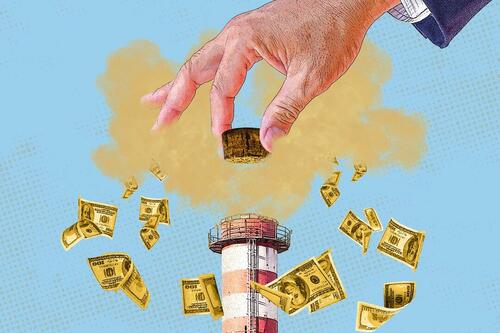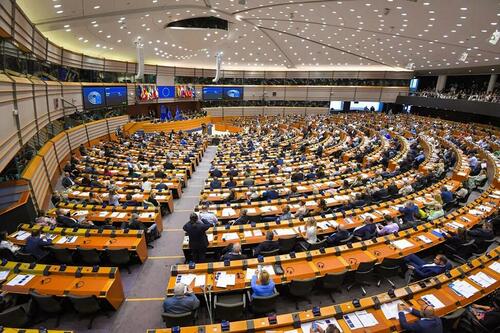Authored by Kevin Stocklin via The Epoch Times (emphasis ours),
The United States is following Europe’s lead in instituting cap-and-trade regimes to reduce CO2 emissions, but America’s journey is split between two paths—Democrat-run states that have passed cap-and-trade mandates, and Republican-run states that appear to have no intention of doing so.

In the middle are several swing states that have entered, then exited, cap-and-trade pacts, depending on which party gains the upper hand.
As global demand for oil, gas, and coal hits record levels and shows no signs of slowing, cap-and-trade has been hailed as an alternative way to reduce the use of fossil fuels by setting caps on how much CO2 companies can emit, and then allowing those that exceed the cap to purchase credits from companies that emit less, or to invest in projects, such as preserving forests, that purport to offset emissions.
The financial currency of the cap-and-trade market is called an “allowance,” which gives companies the right to emit greenhouse gasses. Each allowance is valued in terms of tons of emitted CO2, currently priced at less than $10 per ton, though organizations such as the World Bank have said that pricing in the range of $50–$100 per ton is needed to meet the net-zero goals of the Paris Climate Accords.
Advocates of cap-and-trade hail it as a “market-based” solution.
“Cap and trade harnesses the power of the market to fight global warming,” a report by the Environmental Defense Fund states.
“The cap on emissions guarantees the environmental results we need,” the report states. “Trading gets it done in the cheapest way possible.”
But some critics are skeptical, arguing that it is essentially a tax on energy that gets passed on to consumers and commuters, and that insiders may benefit more than the environment from the enormous sums of cash paid into the system.
“Cap-and-trade is a very interesting theoretical model to try to solve a policy problem, but it’s one that ultimately ends up just moving the costs around,” Ryan Yonk, an energy economist at the American Institute for Economic Research, told The Epoch Times.
“Ultimately, the people that pay are the end consumers. The people that benefit are the market creators, and that’s really one of the major concerns,” Mr. Yonk said.
“If you’re going to have a cap-and-trade system, those that are facilitating the transactions, the middlemen that are involved, will ultimately be those that benefit most directly.”
And indeed, an industry has sprung up around carbon pricing regimes, with stock exchanges vying to become financial centers for carbon trading and financial firms looking to profit from making markets in this new currency.
In addition, accountants and consultants earn fees to develop investable carbon-offset projects and to quantify the environmental benefits. Companies that develop wind and solar production or carbon-capture technology are also often recipients of carbon-offset payments under these regimes.

Europe led the way in mandating cap-and-trade, establishing the European Union Emissions Trading System (EU ETS) in 2005, which regulates approximately 10,000 manufacturing and energy facilities, as well as air and maritime transport. According to the EU, this system has reduced industrial emissions by 37 percent since its founding.
The Obama administration attempted to implement a nationwide cap-and-trade system, but noted that Americans would end up paying more.
President Barack Obama stated in 2008: “Under my plan of a cap-and-trade system, electricity rates would necessarily skyrocket.”
He said coal powered plants or the natural gas industry, for example, “would have to retrofit their operations—that will cost money [and] they will pass that money on to consumers.”
According to a report by the Heritage Foundation, enabling legislation in Congress “failed to reach President Barack Obama’s desk because constituents gave their members an earful that cap and trade would amount to a massive energy tax.”
Since then, Democrats have been successful in implementing these mandates only at the state level.
According to the Center for Climate and Energy Solutions, more than one-fourth of Americans now reside in a state with a cap-and-trade program, which together comprise one-third of U.S. GDP.
In 2009, Connecticut, Delaware, Maine, New Hampshire, New Jersey, New York, Vermont, Massachusetts, Rhode Island, and Maryland officially launched the Regional Greenhouse Gas Initiative, a cap-and-trade pact that ultimately expanded to include a dozen states throughout the northeast and Mid-Atlantic region.
California enacted its own cap-and-trade regime in 2012, and advocates say it has generated significant results.
A May report by California’s Air Resources Board stated that the state’s cap-and-trade program has funded $28 billion in climate-related investments over the past decade. Of the money spent, $11 billion financed various projects to “fight climate change and cut pollution.”
The remaining $17 billion was designated for projects such as putting affordable housing near job centers, building high-speed rail, and “adding zero-emission transportation options in underserved communities.”
In 2021, Washington State established a similar program, calling it “cap-and-invest,” through its Climate Commitment Act (CCA). The state now conducts quarterly auctions of CO2 allowances that emitters must purchase if they exceed emissions caps. The caps will be progressively reduced so that the state can get to net-zero emissions by 2050.
“These 2030, 2040, and 2050 limits were set into state law before the CCA was passed, and they’re based on the latest climate science,” Caroline Halter, communications manager for Washington’s Department of Ecology Climate Pollution Reduction Program, told The Epoch Times.
“In other words, they’re what scientists have said all governments need to do in order to avoid the worst impacts of climate change.”
Read more here...